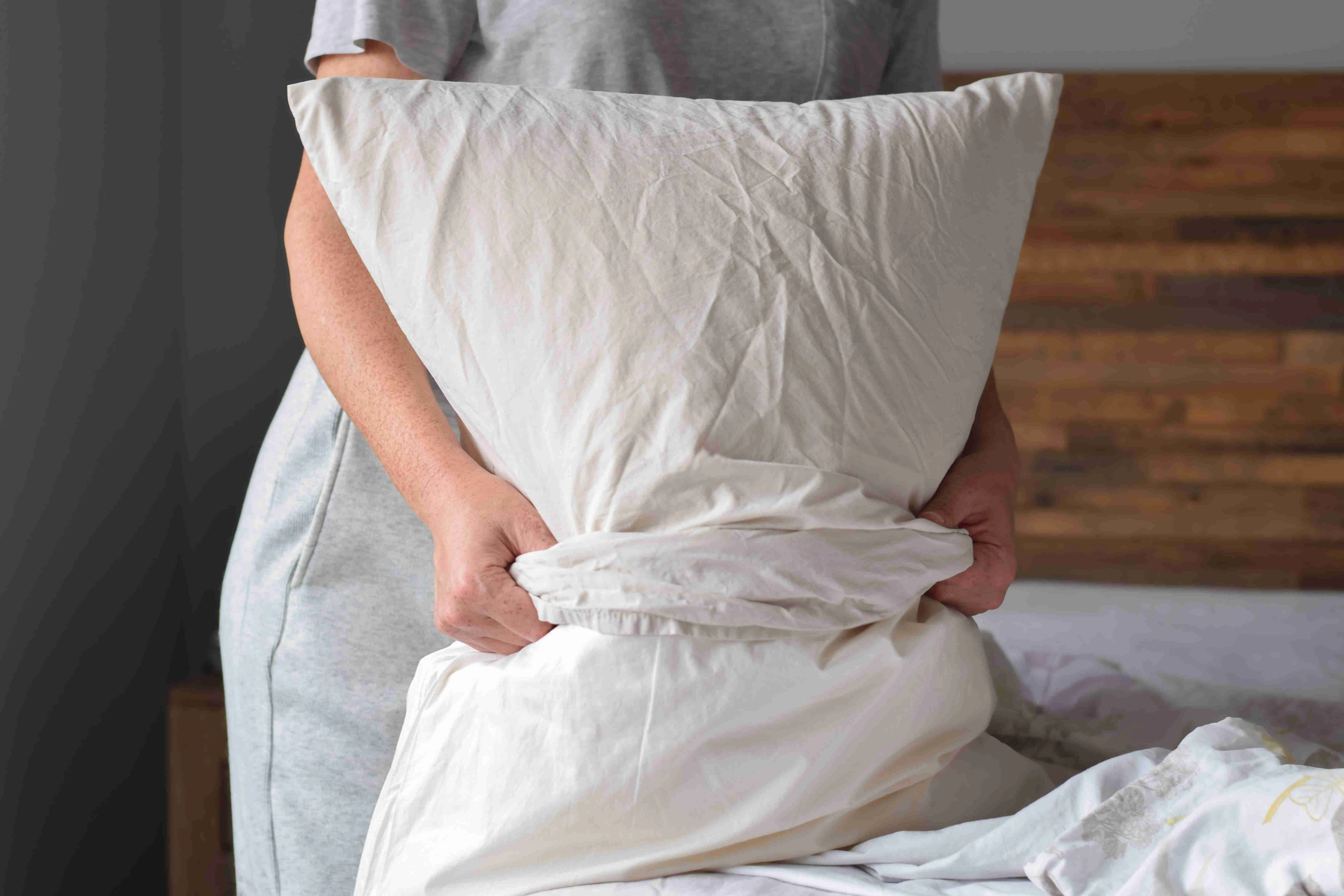Pillows are an essential and integral part of sleep, contributing as much to a restful and rejuvenating sleep as other factors such as the mattress and the sleep environment.
If your pillow doesn't provide a sufficient level of comfort, it can significantly impact your sleep pattern and quality. Often, this is due to the pillow becoming lumpy.
Many people deal with lumpy pillows without even understanding why they developed these lumps, whether there's a way to fix a lumpy pillow, or whether they should replace the pillow entirely with a new one. To achieve a better night's sleep and improve our overall quality of life, it's crucial to understand why pillows become lumpy and whether there are methods to combat this recurring problem.
What is a lumpy pillow?
Lumpy pillows mean that they develop uneven and uncomfortable lumps over time. Various factors, such as shifting filling materials or the breakdown of the pillow's structure, can cause these lumps.
When a pillow becomes lumpy, it can no longer provide the necessary pillow support and comfort for a restful sleep. This can lead to neck and back pain and disrupted sleep patterns.
Why Do Pillows Become Lumpy?
- Breakdown of Materials: Pillows are often made from materials such as cotton, polyester, or memory foam, which can gradually break down over time with regular use. As we lay our heads on the pillow night after night, the pressure and movement can cause the materials to compress and lose their original structure. This compression leads to the formation of lumps and unevenness, making the pillow less supportive and comfortable.
- Moisture and Humidity: When we sleep, our bodies naturally release moisture through sweat. This moisture can seep into the pillow; over time, this moisture can accumulate and cause the filling to clump together, resulting in an uneven and lumpy surface. Additionally, humid conditions promote the growth of mold and mildew, which can affect the integrity of the pillow's filling.
- Wear and Tear: Constant use of the pillow can result in a lumpy texture. As we sleep on our pillows night after night, the weight and pressure exerted on them can gradually break down the fibers or foam inside. This wear and tear leads to a loss of support and structure, especially if it's an old pillow, causing the pillow to lose its shape and become lumpy.
Common Pillow Types That Tend to Become Lumpy
When it comes to pillow types, comfort and support are key factors for a good night's sleep. However, not all pillow types are equal, and some are prone to lumpiness over time.
Polyester-Filled Pillow
Polyester fill tends to clump together and lose its shape, resulting in an uneven and uncomfortable sleeping surface. This can be particularly frustrating for those who prefer a soft and fluffy pillow, as the lumps can create pressure points and disrupt sleep.
Down-Filled Pillows
Down pillows can also become lumpy over time. While down is known for its luxurious feel and ability to conform to the shape of the head and neck, the feathers can shift and bunch up, leading to an uneven surface.
This can be especially problematic for individuals with neck or back pain, as the lumps can exacerbate discomfort and affect sleep quality.
Feather Pillows
Feather pillows are filled with feathers or down that can eventually clump together, creating an uneven and lumpy surface. These clumps can create pressure points and fail to provide the necessary support for a good night's sleep.
While feather pillows are initially soft and comfortable, they may lose their shape and become lumpy after extended use.
Cotton Pillows
Cotton pillows are popular due to their natural and breathable properties. However, the cotton fibers inside the pillow can break down and compress over time, leading to the formation of lumps.
As the cotton becomes compacted, it loses its ability to provide proper support to the head and neck, resulting in an uncomfortable sleeping experience.
Microbead Pillows
Tiny polystyrene beads fill these pillows, conforming to the shape of the head and neck. However, with continuous use, these beads can shift and clump together, creating an uneven surface.
The lumps can affect the overall comfort and support provided by the pillow, making it necessary to replace it or regularly fluff it up to redistribute the beads.
Memory Foam Shredded Pillow
Memory foam is known for its ability to contour to the body, providing personalized support and pressure relief. However, over time, the material can break down and lose its original shape, especially in the shredded memory foam pillows.
This can lead to uneven support and lumps or indentations in the pillow. It is important to note that the quality of the memory foam used in the pillow can greatly impact its longevity and resistance to lumpiness.
How to Fix a Lumpy Pillow: Step-by-Step Guide

A lumpy pillow can make it difficult to get a good night's sleep and lead to discomfort and neck pain. Fortunately, there are several steps you can take to fix a lumpy pillow and restore its original shape and fluff.
Step 1: Fluffing Your Pillow by Hand
The first step is to fluff the pillow by hand. Gently grab the sides of the pillow and squeeze it to redistribute the filling. This will help to break up any clumps and restore the pillow's loft.
Repeat this process several times until the pillow feels more even and smooth.
Step 2: Massage the Lumps
Use your hands to gently knead and squeeze the pillow, focusing on the areas that feel the lumpiest. This will help to separate any clumps and allow the filling to redistribute more evenly. Being too rough could damage the pillow or distort the filling.
Step 3: Wash the Pillow
Examine the care instructions on the pillow's tag to ascertain whether machine washing is safe or if hand washing is necessary. If you can machine wash the pillow, put it in a front-loading washing machine using a mild detergent.
To ensure the removal of all soap residue, use a gentle cycle with cold water and add a few extra rinses. After washing, carefully dry the pillow in a dryer on low heat or lay it flat to air dry.
Step 4: Use a Dryer to Fix Lumps With Tennis Balls
Place the lumpy pillow in the dryer along with a couple of tennis balls. The tennis balls will act as agitators, helping to break up the lumps and redistribute the filling evenly. It is important to set the dryer on a low heat setting to avoid damaging the pillow or its cover.
Allow the pillow to tumble in the dryer for about 20 minutes, periodically checking its progress. Once you are satisfied with the results, remove the pillow from the dryer and give it a good shake to further distribute the filling.
Step 5: Air Out and Sunbathe the Pillow
Consider sunbathing your lumpy pillow. Exposing the pillow to direct sunlight can help to kill any bacteria or mold that may be causing unpleasant odors or contributing to lumpiness.
Place the pillow outside in a sunny spot for a few hours, making sure to flip it over halfway through to ensure both sides receive sunlight exposure.
Always check your pillow's care instructions before sunbathing, as some materials may not be suitable for prolonged sun exposure.
Common Mistakes to Avoid When Fixing a Lumpy Pillow
When it comes to fixing a lumpy pillow, some common mistakes should be avoided in order to achieve the desired result and to ensure that your pillows are fluffed up evenly and free of lumps, providing you with a comfortable night's sleep.
Avoid High Heat in the Dryer
One of the most important things to remember is to avoid using high heat in the dryer. The temptation to quickly fluff the pillow by raising the temperature can actually do more harm than good.
High heat can damage the filling material and make it clump together even more, resulting in an even lumpier pillow. It's best to use a low or medium heat setting and allow the pillow to dry slowly and evenly.
Don’t Overstuff the Dryer
Overstuffing the dryer can lead to overcrowding and prevent the pillows from getting evenly fluffed and dried. Overcrowding the dryer can overdry some pillows, leaving others lumpy.
To ensure that each pillow gets the attention it needs, it's best to only dry one or two pillows at a time. This will enhance airflow and guarantee uniform fluffing and drying of each pillow.
Ignoring the Pillow Care Label
The care label provides important instructions on how to properly clean and maintain the pillow. By ignoring these instructions, you risk damaging the pillow further or not being able to fix the lumps effectively.
It is important to carefully read and follow the care label's recommendations, such as using the appropriate washer cycle or avoiding certain cleaning products.
Expert Tips for Maintaining a Lump-Free Pillow

There is a collection of simple and easy tips that you can follow to maintain a lump-free pillow. By taking these simple steps, you can prolong the life of your pillow and enjoy a peaceful night's sleep.
Invest in Quality Pillows
Choose pillows with proper filling and high-quality materials when making your purchase. High-quality pillows are less likely to develop lumps, providing better support and comfort.
Check out our Best Pillows List that you can buy to improve the quality of your sleep.
Keep Your Pillow Dry
Ensure that your pillow is completely dry before using it. Moisture can lead to clumping and lumps in the filling, affecting the pillow's shape and support.
We recommend air drying your pillow after washing or using a low-heat setting in the dryer to achieve this.
Maintain Your Pillow Hygiene
Regular pillow cleaning helps to prevent the buildup of dirt, oils, and sweat, which can contribute to lump formation.
It is advisable to buy a quality pillowcase and wash it at least once a week using a gentle cycle with mild detergent.
Check how you can Choose the Right Pillowcase.
Use a Pillow Protector
Using a hypoallergenic pillow protector can provide an extra layer of protection against allergens and stains, keeping your pillow fresh and free from lumps for a longer period.
Follow the Care Instructions
Always check the care label on your pillow for specific washing and drying instructions. Some pillows can be machine washed, while others may require spot cleaning only.
Rotate and Fluff Frequently
It is crucial to fluff and rotate your pillow regularly. Fluffing helps to redistribute the pillow stuffing, preventing any clumping or lumping.
Additionally, rotating your pillow every few weeks ensures that it wears evenly and maintains its shape.
FAQs
Why does a pillow become lumpy?
Several factors can lead to a lumpy pillow. The breakdown of the filling material over time is one of the main causes. With regular use, these materials can start to break down and lose their shape. Improper care and maintenance could also contribute to this issue. Additionally, washing the pillow incorrectly or using the wrong detergent can lead to clumping and lumpiness.
How does a lumpy pillow affect sleep quality?
It fails to provide proper support to the head and neck, leading to discomfort and strain. As a result, it becomes difficult to find a comfortable sleeping position, causing restlessness throughout the night. The uneven surface of a lumpy pillow can also create pressure points, leading to pain in the neck, shoulders, and back. This discomfort can disrupt sleep patterns and prevent deep, restorative sleep.
Does fabric softener help lumps?
Usually, entangled or clumped fibers cause lumps in fabric. Fabric softeners aim to soften the fabric and lessen static cling, but they don't influence lump formation.
How Often Should I Fluff My Pillow?
Generally, you should fluff your pillow every morning to keep it plump and supportive for a restful night's sleep. However, pillows with down or feather fillings, which tend to compress over time, may require more frequent fluffing. Additionally, if you notice that your pillow feels flat or lumpy during the night, you may need to fluff it again before going to bed.
Can I fix my lumpy pillow without a dryer?
Yes. While the dryer can help fluff up a pillow, there are alternative methods that can help restore its shape and comfort. One method is to manually manipulate the pillow by kneading and squeezing it to redistribute the filling. Another technique is to place the pillow in the sun for a few hours, allowing the heat to expand the filling and reduce the lumps.
When should I consider pillow replacement?
A general guideline for replacing pillows is every 1 to 2 years, but this can vary depending on the quality of the pillow and individual preferences. If you notice that your pillow has become lumpy and no longer provides adequate support, it may be time to invest in a new one. Additionally, experiencing neck or shoulder pain upon waking or noticing an increase in allergies or asthma symptoms could indicate the need to replace your pillow.
Why is my pillow lumpy and uncomfortable, even after trying to fix it? What can I do without buying a new one?
You can try to adjust the pillow fill. You can fluff pillows to redistribute the feather or down by massaging and fluffing the pillow. Alternatively, if your pillow has a removable cover, you can try adding or removing some of the filling to achieve a more comfortable density. Another option is to invest in a pillow topper or mattress topper, which can provide extra cushioning and support for your head and neck and increase pillow lifespan and longevity.
Conclusion
Fixing a lumpy pillow is a simple process that can greatly improve your comfort and sleep quality. By identifying the cause of the lumpiness, such as clumping or shifting of the filling, you can take appropriate action to fix it.
Fluffing and shaking the pillow regularly can help redistribute the filling and restore its original shape. Additionally, using a pillow protector or case can prevent the filling from clumping together over time. If necessary, adding or removing filling can also help adjust the pillow's firmness and eliminate lumps.
Dom Abraham
As the lead content writer at Sleepiverse. Dom pours his heart into writing mattress reviews, bedding product reviews, and medically-reviewed health articles. Dom is from Portugal and likes to spend his free time writing on the beach as it gives him a sense of comfort. Aside from writing mattress reviews in front of the soothing beach view, Dom likes to experiment with new amazing food ideas.


